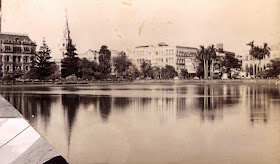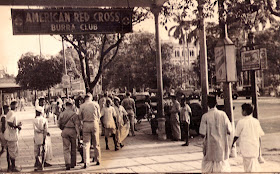This map is shows the extent of Imperial Japanese occupation of China in 1940:
Enlarged into Preview, it shows clearly a great deal of the geography we need to get straight.
Reference points for our story include:
1. Ledo, Myitkyina, and the Burma-China border;
2. Yunnan Province, where I am guessing Gene is at a KMT HQ not too far from the border, at this point in the photographic series;
3. Kunming, big trading city with a lake and a canal, and as you can see here, a rail line from Indo-China;
4. Sichuan Province, where they like hot peppers in their food, with Chongqing, where Chiang Kai-shek established the provisional capital of Free China, the Japanese having occupied most of the other major cities;
5. Shaanxi Province, containing Hsian ( = Xi'an,) claimed to be the oldest city in China, and where, soon in our story in the summer of 1945, OSS Detachment 202 will set up a field base;
6. A rail line, running east-west, north of Hsian.
That rail line crosses the Yellow River ( = Hwang-Ho.) The double-track rail bridge over the Yellow River is vitally useful to the Imperial Japanese Army.
So now I will give the story away. OSS Detachment 202 will deploy Team Jackal out of Hsian to blow up that bridge - indeed, to blow up three bridges in that area simultaneously. Private Eugene Zdrojewski will be a member of that Team.
Two thousand Imperial Japanese troops will be on a train on the Yellow River Bridge when it blows.


























